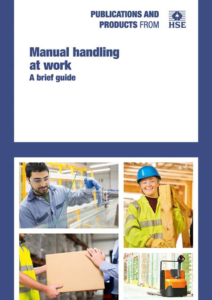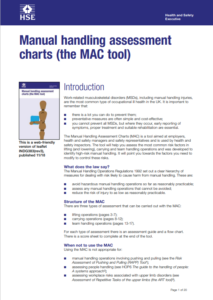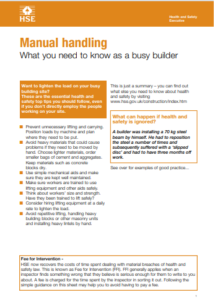HSE BUILDING SITE INSPECTIONS
HSE inspectors will visit construction sites across England, Scotland and Wales in September and October to check that workers’ health is being protected from the risks associated with moving and handling materials. They will look for evidence of employers and workers:
- Knowing the risks.
- Planning their work to eliminate or substitute the risks where possible.
- Using the right controls where elimination or substitution of the risks is not possible.
Free resources
We have created these campaign pages and assets to help make sure you consider all the risks and act now to protect you and your colleagues.
Download our free manual handling resources below, share them with those on site and discuss together how to keep everyone safe.
These provide essential health and safety advice you should follow, even if you don’t directly employ the people working on your site.
What are the risks?
Construction work, by its very nature, involves lifting, carrying and handling activities that can cause significant, often long-term injuries if the risks are not managed effectively.
Construction workers have a high risk of developing aches, pains and discomfort in muscles and joints, referred to as musculoskeletal disorders (MSDs).
These injuries can seriously impact on workers performance and their ability to stay in work. Working days lost through MSDs have huge financial implications for businesses, as well as time spent to recruit and train replacement workers if needed. These injuries can often be reoccurring, so it’s important to get the control measures right to protect workers’ long-term health, wellbeing and ability to remain in work.
YOUR LEGAL RESPONSIBILITIES
As an employer, you must protect your workers from getting hurt or ill through work.
If you don’t, you could get:
- verbal or written advice,
- an improvement or prohibition notice,
- or be prosecuted by HSE or your local authority.
THE LAW: WHAT YOU NEED TO KNOW
AVOID, ASSESS, REDUCE
- Avoid hazardous manual handling operations so far as reasonably practicable.
- Assess any manual handling operations that cannot be avoided.
- Reduce the risk of injury to as low as reasonably practicable.
ARE YOU A SMALL BUILDER? YOUR LEGAL DUTIES ARE THE SAME ON A SMALL OR LARGE BUILDING SITE
A small builder is a contractor and includes sub-contractors or any individual self-employed worker.
A contractor is anyone who directly employs or engages construction workers or manages construction work. The law requires that a contractor must have the skills, knowledge and experience to carry out work safely and without risk to health.
Find out what you need to do to carry out your duties on both commercial and domestic contracts.
HEALTH & SAFETY IN THE CONSTRUCTION INDUSTRY
HSE has a long-term commitment to improve the health of workers in the construction industry. Find out more about how you can meet your legal responsibilities as an employer and protect your workers from short and long-term harm.
Find out more: Construction – Health and safety for the construction industry (hse.gov.uk)







